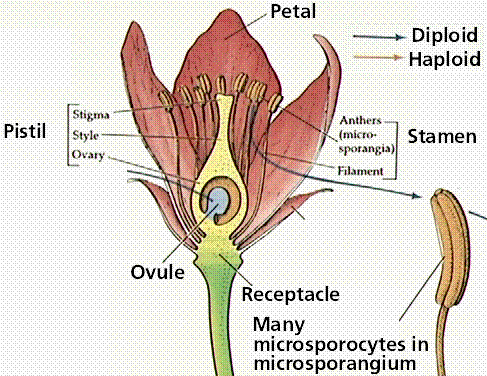
5) The Quran on Reproduction in Plants:
One must bear in mind that there are two methods of reproduction in the plant kingdom: one sexual, the other asexual. It is only the first which in fact deserves the term 'reproduction', because this defines a biological process whose purpose is the appearance of a new individual identical to the one that gave it birth.
Asexual reproduction is quite simply multiplication. It is the result of the fragmentation of an organism which has separated from the main plant and developed in such a way as to resemble the plant from which it came. It is considered by Guilliermond and Mangenot to be a 'special case of growth'. A very simple example of this is the cutting: a cutting taken from a plant is placed in suitably watered soil and regenerated by the growth of new roots. Some plants have organs specially designed for this, while others give off spores that behave like seeds, as it were, (it should be remembered that seeds are the results of a process of sexual reproduction).
Sexual reproduction in the plant kingdom is carried out by the coupling of the male and female parts of the generic formations united on a same plant or located on separate plants. This is the only form that is mentioned in the Quran.
Sura 20, verse 53:
"(God is the One Who) sent water down from the sky and thereby we brought forth pairs of plants each separate from the other."
'One of a pair' is the translation of zauj (plural azwaj) whose original meaning is: 'that which, in the company of another, forms a pair'; the word is used just as readily for a married couple as for a pair of shoes.
Sura 22, verse 5:
"Thou seest the grounds lifeless. When We send down water thereon it shakes and grows and puts forth every magnificent pair (of plants)."
Sura 31, verse 10:
"We caused to grow (on the earth) every noble pair (of plants)."
Sura 13, verse 3:
"Of all fruits (God) placed (on the earth) two of a pair."
We know that fruit is the end-product of the reproduction process of superior plants which have the most highly developed and complex organization. The stage preceding fruit is the flower, which has male and female organs (stamens and ovules). The latter, once pollen has been carried to them, bear fruit which in turn matures and frees its seeds. All fruit therefore implies the existence of male and female organs. This is the meaning of the verse in the Quran.

It must be noted that for certain species, fruit can come from non-fertilized flowers (parthenocarpic fruit), e.g. bananas, certain types of pineapple, fig, orange, and vine. They can nevertheless also come from plants that have definite sexual characteristics.
The culmination of the reproductive process comes with the germination of the seed once its outside casing is opened (sometimes it is compacted into a fruit-stone). This opening allows roots to emerge which draw from the soil all that is necessary for the plant's slowed-down life as a seed while it grows and produces a new plant.
A verse in the Quran refers to this process of germination:
Sura 6, verse 95:
"Verily, God splits the grain and the fruit-stone."
The Quran often restates the existence of these components of a pair in the vegetable kingdom and brings the notion of a couple into a more general context, without set limits:
Sura 36, verse 36:
"Glory be to Him Who created the components of couples of every kind: of what the ground caused to grow, of themselves (human beings) and of what you do not know."
One could form many hypotheses concerning the meaning of the 'things men did not know' in Mohammed's day. Today we can distinguish structures or coupled functions for them, going from the infinitesimally small to the infinitely large, in the living as well as the non-living world. The point is to remember these clearly expressed ideas and note, once again, that they are in perfect agreement with modern science.
Next: The Quran on Mountains